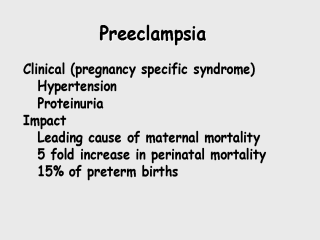 |
Preeclampsia is a pregnancy specific condition
that's recognized by the presence of high blood pressure in a woman who's pregnant and who
didn't previously have high blood pressure, and the appearance of proteins in the urine in
a pregnant woman who didn't previously have protein in the urine. This usually occurs in
the last half, and more commonly, in the last three or four weeks of pregnancy. It's a
major problem; it's the leading cause of maternal mortality. In developed countries like
the United States, the major cause of death during pregnancy is car accidents, so we're
not talking about huge numbers of women in this country dying but it is in fact the
leading cause of death in this country. In the majority of developing countries, where
maternal mortality might be 30 to 40 times what it is in this country, this is one of the
leading causes and in some settings, it may count for as much as 50 to 80 percent of
maternal deaths. In our country the major issue is that there's a 5-fold increase in
perinatal mortality, which is especially pertinent to talking about prevention, because
some of that perinatal mortality comes from treating disease. The disease is pregnancy
specific so once she has her baby she'll be fine. The vast majority of women and babies
have a successful outcome. But about 10 percent of babies are early enough into pregnancy
that their early delivery contributes to the fact that about 15 percent of preterm births
are indicated deliveries for preeclampsia. |
